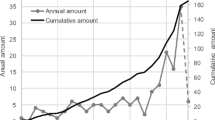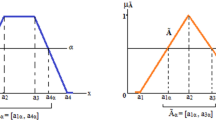Abstract
To improve today’s complex systems composed of personnel, hardware, software and methods, it is necessary to identify, prioritize and select projects to eliminate the causes of underperformance. In this study, a methodology based on fuzzy analytical hierarchy process (FAHP) for decision-making, integrated with cause-and-effect diagrams used in quality improvement studies, is proposed for this purpose. It is assumed that the resources for improvement are scarce and the best use of these is needed. To guide practitioners, the methodology is illustrated with a real-world implementation for identification, prioritization and selection of improvement projects for a poor performing appointment system at a hospital. The cause-and-effect diagram is used to identify and organize the causes and their sub-causes leading to the poor performance, and to create a hierarchy of these by using the information obtained from experts, staff and patients. In order to prioritize the major and sub-causes as potential improvement project topics, FAHP methodology, which utilize human cognition and judgment power based on knowledge and experience, is applied and used for decision-making. The priorities corresponding to each major cause and sub-cause can be used to make a decision on improvement projects and their order due to scarce resources. The methodology is general and can be used in various application domains.


Similar content being viewed by others
References
Abbod MF, Keyserlingk DG, Linkens DA, Mahfouf M (2001) Survey of utilisation of fuzzy technology in medicine and healthcare. Fuzzy Sets Syst 120(2):331–349
Bhattacharjee P, Ray P (2015) Simulation modelling and analysis of appointment system performance for multiple classes of patients in a hospital: a case study. Oper Res Health Care 8:71–84
Chang D-Y (1996) Applications of the extent analysis method on fuzzy AHP. Eur J Oper Res 95(3):649–655
Chang T-H (2014) Fuzzy VIKOR method: a case study of the hospital service evaluation in Taiwan. Inf Sci 271:196–212
Chauhan A, Singh A (2016) A hybrid multi-criteria decision making method approach for selecting a sustainable location of healthcare waste disposal facility. J Clean Prod 139:1001–1010
Deng H (1999) Multicriteria analysis with fuzzy pairwise comparisons. Int J Approx Reason 21:215–231
Dursun M, Karsak EE, Karadayi MA (2011) A fuzzy multi-criteria group decision making framework for evaluating health-care waste disposal alternatives. Expert Syst Appl 38(9):11453–11462
Flood A, Latino RJ (2004) Optimizing FMEA and RCA efforts in health care. J Healthcare Risk Manag 24(3):21–28
Harding KE, Bottrell J (2016) Specific timely appointments for triage reduced waiting lists in an outpatient physiotherapy service. Physiotherapy 102:345–350
Hasin M, Seeluangsawat R, Shareef M (2001) Statistical measures of customer satisfaction for health care quality assurance: a case study. Int J Health Care Qual Assur 14(1):6–14
Hatcher M (1994) Voting and priorities in health care decision making, portrayed through a group decision support system, using analytic hierarchy process. J Med Syst 18(5):267–288
Ishizaka A, Labib A (2009) Analytic hierarchy process and expert choice: benefits and limitations. OR Insight 22(4):201–220. doi:10.1057/ori.2009.10
Javid AA, Jalali Z, Klassen KJ (2016) Outpatient appointment systems in healthcare: a review of optimization studies. Eur J Oper Res 258:3–34. doi:10.1016/j.ejor.2016.06.064
Kuo RJ, Wu YH, Hsu TS (2012) Integration of fuzzy set theory and TOPSIS into HFMEA to improve outpatient service for elderly patients in Taiwan. J Chin Med Assoc 75(7):341–348
Lee A, Chen WC, Chang CJ (2008) A fuzzy AHP and BSC approach for evaluating performance of IT department in the manufacturing industry in Taiwan. Expert Syst Appl 34(1):96–107
Liberatore MJ, Nydick RL (2008) The analytic hierarchy process in medical and health care decision making: a literature review. Eur J Oper Res 189:194–207
Low C, Chen YH (2012) Criteria for the evaluation of a cloud-based hospital information system outsourcing provider. J Med Syst 36(6):3543–3553
Mahfouf MM, Abbod MF, Linkens DA (2001) A survey of fuzzy logic monitoring and control utilisation in medicine. Artif Intell Med 21(1):27–42
Montgomery DC (2013) Statistical quality control: a modern introduction, 7th edn. Wiley, Singapore
Moreno JM (2010) A quality evaluation methodology for health-related websites based on a 2-tuple fuzzy linguistic approach. Soft Comput 14(8):887–897
Saaty TL (1980) The analytic hierarchy process, planning, priority setting, resource allocation. McGraw-Hill, New York
Singh A, Prasher A (2017) Measuring healthcare service quality from patients’ perspective: using Fuzzy AHP application. Total Qual Manag Bus Excell. doi:10.1080/14783363.2017.1302794
Testik ÖM, Shaygan A, Dasdemir E, Soydan G (2017) Selecting health care improvement projects: a methodology integrating cause-and-effect diagram and analytical hierarchy process. Qual Manag Health Care 26(1):40–48
Tsai H-Y, Chang C-W, Lin H-L (2010) Fuzzy hierarchy sensitive with Delphi method to evaluate hospital organization performance. Expert Syst Appl 37:5535–5541
Vahidnia MH, Alesheikh AA, Alimohammadi A (2009) Hospital site selection using fuzzy AHP and its derivatives. J Environ Manag 90(10):3048–3056
White AA (2004) Cause-and-effect analysis of risk management files to assess patient care in the emergency department. Acad Emerg Med 11(10):1035–1041
Wong K (2011) Using an Ishikawa diagram as a tool to assist memory and retrieval of relevant medical cases from the medical literature. J Med Case Rep 5(1):120
Wu WY, Hsiao SW, Kuo HP (2004) Fuzzy set theory based decision model for determining market position and developing strategy for hospital service quality. Total Qual Manag Bus Excell 15(4):439–456
Wu C-R, Chang C-W, Lin H-L (2008) FAHP sensitivity analysis for measurement nonprofit organizational performance. Qual Quant 42(3):283–302
Yu SC, Lin YH (2008) Applications of fuzzy theory on health care: an example of depression disorder classification based on FCM. WSEAS Trans Inf Sci Appl 5(1):31–36
Zadeh L (1965) Fuzzy sets. Inf Control 8:338–353
Zadeh LA (1968) Fuzzy algorithms. Inf Control 12(2):94–102
Acknowledgements
We would like to thank the reviewers and the associate editor for constructive comments, which helped improving the paper.
Author information
Authors and Affiliations
Corresponding author
Ethics declarations
Conflict of interest
The authors declare that they have no conflict of interest.
Ethical approval
This article does not contain any studies with human participants or animals performed by any of the authors.
Informed consent
Informed consent was obtained from all individual participants included in the study.
Additional information
Communicated by V. Loia.
Appendix. Resulting fuzzy comparison matrices
Appendix. Resulting fuzzy comparison matrices
1. Capacity
1 | 2 | |||||
|---|---|---|---|---|---|---|
1 | 1.00 | 1.00 | 1.00 | 1.25 | 1.75 | 2.25 |
2 | 0.44 | 0.57 | 0.80 | 1.00 | 1.00 | 1.00 |
1.1. Improving the appointment schedule
1 | 2 | 3 | 4 | |||||||||
|---|---|---|---|---|---|---|---|---|---|---|---|---|
1 | 1.00 | 1.00 | 1.00 | 0.50 | 0.75 | 1.00 | 0.40 | 0.50 | 0.67 | 0.29 | 0.33 | 0.40 |
2 | 1.00 | 1.33 | 2.00 | 1.00 | 1.00 | 1.00 | 0.40 | 0.50 | 0.67 | 0.40 | 0.50 | 0.67 |
3 | 1.50 | 2.00 | 2.50 | 1.50 | 2.00 | 2.50 | 1.00 | 1.00 | 1.00 | 1.00 | 1.33 | 2.00 |
4 | 2.50 | 3.50 | 4.00 | 1.50 | 2.00 | 2.50 | 0.50 | 0.75 | 1.00 | 1.00 | 1.00 | 1.00 |
2. System and connection related
1 | 2 | 3 | 4 | |||||||||
|---|---|---|---|---|---|---|---|---|---|---|---|---|
1 | 1.00 | 1.00 | 1.00 | 1.50 | 2.00 | 2.50 | 3.50 | 4.00 | 4.50 | 0.50 | 0.75 | 1.00 |
2 | 0.40 | 0.50 | 0.67 | 1.00 | 1.00 | 1.00 | 1.50 | 2.00 | 2.50 | 3.00 | 1.33 | 2.00 |
3 | 0.22 | 0.25 | 0.29 | 0.40 | 0.50 | 0.67 | 1.00 | 1.00 | 1.00 | 0.40 | 0.50 | 0.67 |
4 | 3.00 | 1.33 | 2.00 | 0.50 | 0.75 | 1.00 | 1.50 | 2.00 | 2.50 | 1.00 | 1.00 | 1.00 |
2.1. Improving the telecommunication system
1 | 2 | 3 | 4 | |||||||||
|---|---|---|---|---|---|---|---|---|---|---|---|---|
1 | 1.00 | 1.00 | 1.00 | 0.40 | 0.50 | 0.67 | 0.50 | 0.75 | 1.00 | 1.50 | 2.00 | 2.50 |
2 | 1.50 | 2.00 | 2.50 | 1.00 | 1.00 | 1.00 | 1.50 | 2.00 | 2.50 | 1.50 | 2.00 | 2.50 |
3 | 1.00 | 1.33 | 2.00 | 0.40 | 0.50 | 0.67 | 1.00 | 1.00 | 1.00 | 0.50 | 0.75 | 1.00 |
4 | 0.40 | 0.50 | 0.67 | 0.40 | 0.50 | 0.67 | 1.00 | 1.33 | 2.00 | 1.00 | 1.00 | 1.00 |
2.2. Improving the IT system for internet appointments
1 | 2 | 3 | |||||||
|---|---|---|---|---|---|---|---|---|---|
1 | 1.00 | 1.00 | 1.00 | 1.50 | 2.00 | 2.50 | 1.00 | 1.00 | 1.00 |
2 | 0.40 | 0.50 | 0.67 | 1.00 | 1.00 | 1.00 | 0.40 | 0.50 | 0.67 |
3 | 1.00 | 1.00 | 1.00 | 1.50 | 2.00 | 2.50 | 1.00 | 1.00 | 1.00 |
3. Hardware and software related
1 | 2 | 3 | |||||||
|---|---|---|---|---|---|---|---|---|---|
1 | 1.00 | 1.00 | 1.00 | 0.50 | 0.75 | 1.00 | 1.50 | 2.00 | 2.50 |
2 | 1.00 | 1.33 | 2.00 | 1.00 | 1.00 | 1.00 | 0.67 | 1.00 | 1.50 |
3 | 0.40 | 0.50 | 0.67 | 0.67 | 1.00 | 1.50 | 1.00 | 1.00 | 1.00 |
3.1. Improving the software performance
1 | 2 | |||||
|---|---|---|---|---|---|---|
1 | 1.00 | 1.00 | 1.00 | 0.50 | 0.67 | 1.00 |
2 | 1.00 | 1.50 | 2.00 | 1.00 | 1.00 | 1.00 |
3.2. Improving the capabilities of IT department
1 | 2 | |||||
|---|---|---|---|---|---|---|
1 | 1.00 | 1.00 | 1.00 | 0.50 | 0.67 | 1.00 |
2 | 1.00 | 1.50 | 2.00 | 1.00 | 1.00 | 1.00 |
4. Staff related
1 | 2 | |||||
|---|---|---|---|---|---|---|
1 | 1.00 | 1.00 | 1.00 | 3.50 | 4.00 | 4.50 |
2 | 0.22 | 0.25 | 0.29 | 1.00 | 1.00 | 1.00 |
4.1. Reducing inefficiencies caused by doctors
1 | 2 | |||||
|---|---|---|---|---|---|---|
1 | 1.00 | 1.00 | 1.00 | 2.50 | 3.00 | 3.50 |
2 | 0.29 | 0.33 | 0.40 | 1.00 | 1.00 | 1.00 |
4.2. Reducing inefficiencies caused by secretaries
1 | 2 | 3 | |||||||
|---|---|---|---|---|---|---|---|---|---|
1 | 1.00 | 1.00 | 1.00 | 0.40 | 0.50 | 0.67 | 0.40 | 0.50 | 0.67 |
2 | 1.50 | 2.00 | 2.50 | 1.00 | 1.00 | 1.00 | 0.50 | 0.67 | 1.00 |
3 | 1.50 | 2.00 | 2.50 | 1.00 | 1.50 | 2.00 | 1.00 | 1.00 | 1.00 |
6. During appointments problems
1 | 2 | 3 | |||||||
|---|---|---|---|---|---|---|---|---|---|
1 | 1.00 | 1.00 | 1.00 | 0.67 | 1.00 | 1.50 | 0.29 | 0.33 | 0.40 |
2 | 0.67 | 1.00 | 1.50 | 1.00 | 1.00 | 1.00 | 0.22 | 0.25 | 0.57 |
3 | 2.50 | 3.00 | 3.50 | 3.50 | 4.00 | 4.50 | 1.00 | 1.00 | 1.00 |
6.1. Reducing excessive questions asked by patients
1 | 2 | |||||
|---|---|---|---|---|---|---|
1 | 1.00 | 1.00 | 1.00 | 1.25 | 1.75 | 2.25 |
2 | 0.44 | 0.57 | 0.80 | 1.00 | 1.00 | 1.00 |
Rights and permissions
About this article
Cite this article
Shaygan, A., Testik, Ö.M. A fuzzy AHP-based methodology for project prioritization and selection. Soft Comput 23, 1309–1319 (2019). https://doi.org/10.1007/s00500-017-2851-9
Published:
Issue Date:
DOI: https://doi.org/10.1007/s00500-017-2851-9




